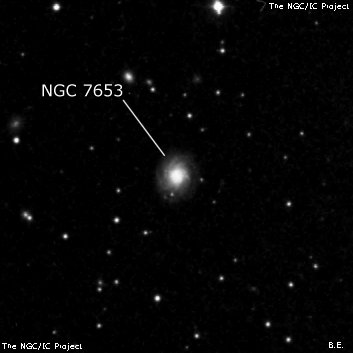
John Herschel discovered NGC 7653 = h2237 on 2 Nov 1823 (sweep 1) and recorded "eF; R; gbM; 30"; appears as M71 does in the 7-feet reflector with the double eye-piece." This galaxy was Herschel's second deep sky discovery. NGC 7010 was discovered earlier on 6 Aug 1823, before formally starting his sweeps (later sequenced as sweep 48 for completeness). The following spring he embarked on a 6 month tour of Europe and his next discovery was not made until 11 Apr 1825 (sweep 3).
Both Harold Corwin and Malcolm Thomson report that IC 1488 has an erroneous position (misidentified offset star) is not identical to NGC 7653 as claimed in the PGC, UGC, etc. The correct identification is IC 1488 = LEDA 2800840, located 12.8' northeast of NGC 7653. See Harold Corwin's identification notes.
400/500mm - 17.5" (7/28/92): fairly faint, fairly small, round, broad concentration to a small bright core.
600/800mm - 24" (9/29/16): at 375x; moderately to fairly bright, moderately large, slightly elongated ~N-S, 1.0'x0.8', bright core, very small well-defined nucleus.
Brightest in a group of galaxies with LEDA 214955 3.2' NNE. This dim galaxy was extremely faint and small, ~6"-8" diameter, only visible occasionally. LEDA 165923, 6.3' ESE, was very faint to faint, small, slightly elongated NNW-SSE, ~15"x11". UGC 12590, 7' SE, appeared fairly faint, fairly small, very elongated 7:2 NNW-SSE, contains a sharp stellar nucleus and faint thin extensions. IC 1488, 12.8' ENE, was faint to fairly faint, fairly small, very elongated 3:1 or 7:2 ~N-S, ~30"x9", contains a very small or stellar nucleus. Only UGC 12590 has the same redshift as NGC 7653. The other mentioned galaxies lie 3 times the distance (~570 million l.y.) and are probably outlying members of Abell Galaxy Cluster 2593, which lies ~35'-40' S.
24" (1/1/16): at 375x; fairly faint or moderately bright, fairly small, slightly elongated N-S, 0.6'x0.5', small bright core. LEDA 214955 is a challenging target 3.2' NNE. It appeared extremely faint (V = 15.6) and small, round, 6" diameter, only visible intermittently.
Notes by Steve Gottlieb